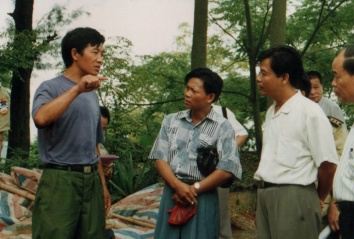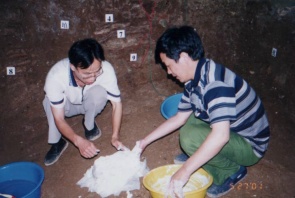FU Xianguo
Date of birth: 1st March, 1960
Place of birth: a village near Jiyuan City, Henan Province.
Email: fuxianguo@hotmail.com
Education and visiting scholarship
1993-1994: Visiting scholar of the Dept. of Anthropology, Washington University, Seattle, USA.
1992-1993: The Harvard-Yanking Visiting Scholar with the Dept. of Anthropology, Harvard University, Boston, USA.
Sep. 1983-June 1986: The Institute of Archaeology, Chinese Academy of Social Sciences, China. MA degree awarded in July 1986.
Sep. 1979-July 1983: Dept. of Anthropology, Sun Yat-Sen University, China. BA degree awarded in 1983
Positions held:
2003-present: Professor, Head of the South China Prehistoric Team, and deputy Director of the Prehistoric Archaeological department of the Institute of Archaeology, CASS.
1996-2003: Associate Professor, Institute of Archaeology, CASS
1986-1996: Assistant Professor, Institute of Archaeology, CASS
Research interest:
Neolithic archaeology in China
Prehistoric archaeology of South China and Southeast Asian
Stone tool analysis
Pottery analysis
Awards:
2002: Second Prize of Excellent Fieldwork awarded by the State Bureau of Antiquity Management for the excavation of the Zengpiyan Cave.
1997: Award of the ‘one of the top ten most important archaeological discoveries in China in 1997’ for discovering and excavating Neolithic Dingsishan in Guangxi, South China.


Fieldworks:
1982: Participating in the excavation of Neolithic site--Xuejiagang in Qianshan County, Anhui Province.
1983: Participating in the excavation of Neolithic site--Pinliangtai in Huaiyang County, Henan Province.
1987: Participating in the excavation of Neolithic site--Shuiquan in Jia County, Henan Province.
1989-1992: Participating in three field seasons of the excavation of Neolithic site--Yunchisi, Mengcheng County, Anhui Province, and a survey in Anhui province.
1995: Participating in the archaeological survey in Jiaozuo District, Henan Province, and the excavation of Shuangyantang site, Chongqing City.
1997: Participating in the excavation of Neolithic site--Tung Wan Tsai, Hong Kong.
1996-present: Directing the South China Prehistoric Team of the Institute of Archaeology, CASS to excavate several sites in Guangxi, South China, including Dingsishan in Yongning County, Baozitou near Nanning City, Taipingyan and Dayan of Lingui County, Zengpiyan of Guilin City, and Liyuzui of Liuzhou City.
Publications:
More than 30 articles and one monograph were published. Main publications are as follows:
1985: Shilun Zhongguo Xinshiqi Shidai de Shiyue (A brief discussion on the stone axe-yue in Neolithic China). Kaogu Vol. 9: 820-829.
1988: Lun Youduan Shiben he Youjian Shiqi (A brief discussion on stepped stone adzes and shouldered stone implements). Kaogu Xuebao Vol.1
1992: Min, Yue, Gangtai Diqu Shiben Hengpoumian de Chubu Kaocha (A preliminary study on the cross-section of stone adzes found in Fujian, Guangdong, Hong Kong and Taiwan). Wenwu Vol.1.
1996: Taiguo Zaoqi Qingtong Wenhua de Faxian yu Yanjiu (The discovery and study of the early Bronze Age remains in Thailand). Huaxia Kaogu Vol. 4
1998: Guangxi Yongning Dingsishan Yizhi Fajue (The report on the excavation of the Dingsishan Site in Yongning County, Guangxi). Kaogu Vol. 11.
2003 Zengpiyan-a Prehistoric Cave in South China (in Chinese with English abstract). chief editor and author of 7 chapters/sections of the book. Beijing: Cultural Relics Publishing House.
Major achievements:
- Establishing the prehistoric chronology dated from 9000 to 3500 BP in Southern Guangxi, South China, and the first archaeological culture – the Neolithic “Dingsishan Culture” in Guangxi, South China.
- Based on data found in Dayan and Zengpiyan, establishing the prehistoric chronology dated from 35,000 to 3500 BP in Northeast Guangxi.
- Contributing to the issues of the chronology, pig domestication and the origin of rice agriculture in northeast Guangxi, South China by providing new data through the excavation and research on the Zengpiyan assemblage.
- Discovering pottery dated to 12,000 BP in Zengpiyan, providing new data for the origin of pottery.
- Revealing the cultural significance of the Dingsishan and Zengpiyan assemblages. The two sites are now enlisted as National Monuments.

